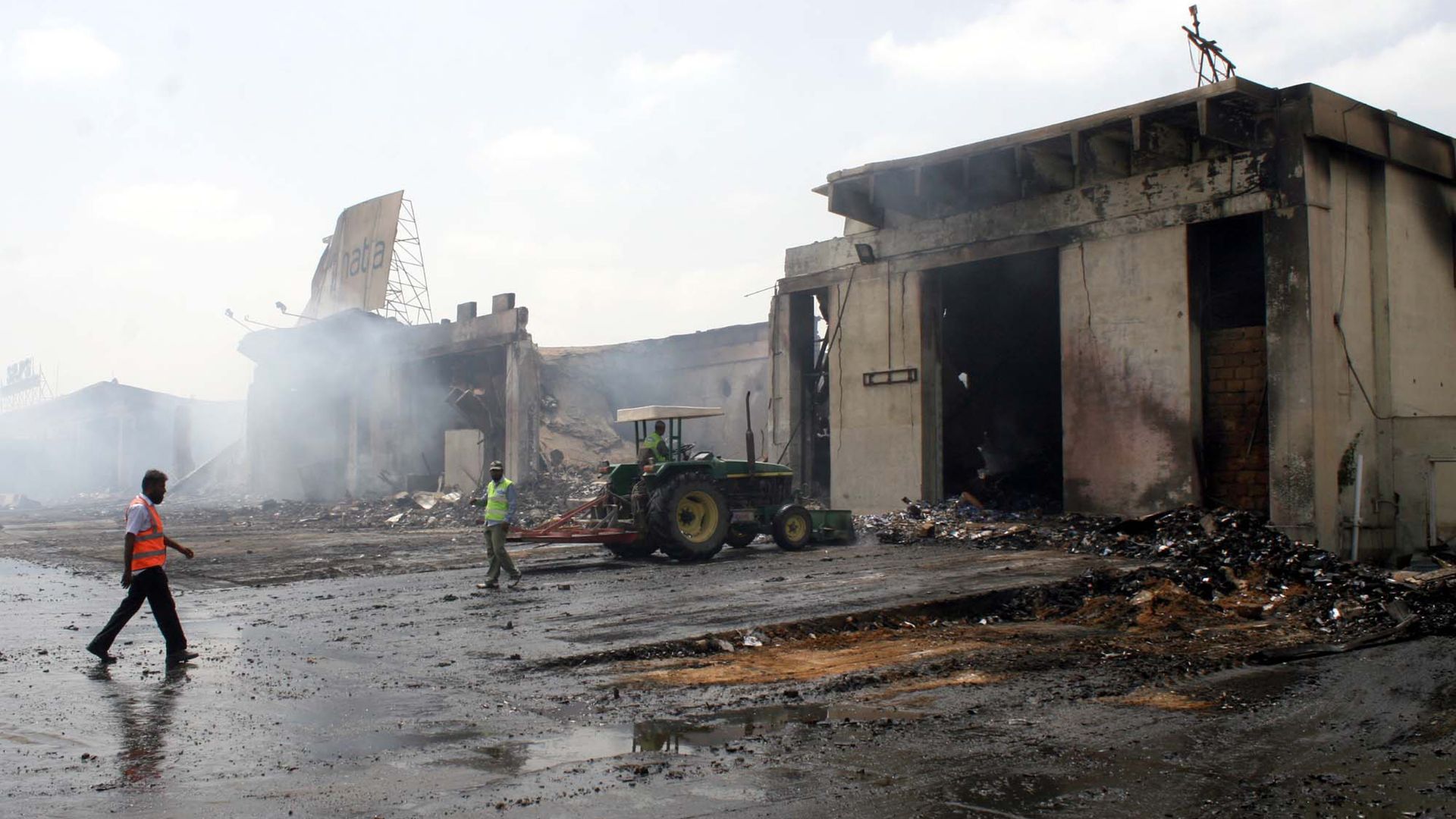Pakistan is in crisis. Imran Khan, its charismatic former prime minister, has run a populist campaign undermining institutions and whipping up mass hysteria. This country of over 230 million faces economic collapse. Extremism is on the rise and the state is unable to provide its citizens security. Internal conflicts now threaten the stability of the country. Even regional stability is at risk.
Pakistan’s terrible economic crisis
Political instability, unfair capitalism, financial mismanagement and the impact of a 2022 natural disaster have contributed to Pakistan’s economic crisis. The devastating flooding last year resulted in billions of dollars in damage, putting immense strain on the country’s agriculture and health sectors. It exposed Pakistan’s susceptibility to climate disasters and revealed concerns about vulnerabilities in governance and economic stability.
The country’s economic model relies on foreign loans. The massive external debt obligations are putting the country at great risk of bankruptcy. Pakistan has various creditors, which fall into four categories: multilateral debt, Paris Club debt, private and commercial loans, and Chinese debt.
Of Pakistan’s $126 billion debt, a large portion totaling $45 billion is owed to multilateral institutions, according to the analysis published by Nilanjan Ghosh of Observer Research Foundation. Some of the main lenders are the World Bank, the Asian Development Bank and the International Monetary Fund (IMF). Pakistan also owes smaller amounts to the Islamic Development Bank and the Asian Infrastructure Investment Bank.
Despite the massive size of Pakistan’s debt, it doesn’t pose major immediate risks for the country. Repayments are made in small installments over time, from 18 to 30 years. This gives Pakistan some time to make payments. In 2022-23, Pakistan paid back a total of $4.5 billion to multilateral creditors, which accounted for one-fifth of the total debt repayment for that year.
Additionally, Pakistan owes the Paris Club $8.5 billion. The Paris Club is a group of 22 creditor countries. Pakistan’s debt is planned to be repaid over a period of 40 years and carries a low interest rate of less than 1%. Most of this debt is owed to countries like Japan, Germany, France and the United States.
Pakistan also has a substantial amount of private debt, primarily in the form of private bonds like Eurobonds and global Sukuk bonds, totaling $7.8 billion. In the previous fiscal year, Pakistan secured $2 billion through the issuance of Eurobonds with different maturity periods—5, 10, and 30 years—and interest rates ranging from 6% to 8.87%. The country currently holds foreign commercial loans amounting to nearly $7 billion. This is expected to increase to approximately $9 billion by the end of the current fiscal year. A great portion of Pakistan’s commercial loan portfolio is owed to Chinese financial institutions, as the country has paid off major non-Chinese commercial loans.
Pakistan’s Chinese debt amounts to about $27 billion, which comprises, among other things $10 billion of bilateral debt and $6.2 billion in Chinese government-provided debt to Pakistani public sector enterprises. China’s State Administration of Foreign Exchange (SAFE) has deposited $4 billion with Pakistan’s central bank. The bilateral debt has favorable terms, with a repayment period of 20 years. Alongside the debt, Pakistan has a currency swap arrangement with China.
Khan’s spectacular downfall
In March 2022, Khan faced a no-confidence motion submitted by the opposition. Khan’s Pakistan Movement for Justice (PTI) party had 155 members and needed at least 172 lawmakers on its side to remain in power. The motion initially failed, receiving favorable votes from 161 members, but gained the votes needed to pass in another vote on April 10.
The confidence vote resulted in key figures quitting. Punjab Chief Minister Sardar Usman Buzdar, a member of PTI, presented his resignation to Khan, who rejected it. After Buzdar’s resignation, the Housing Minister and leader of the coalition partner Pakistan Muslim League-Quaid (PML-Q), Tariq Bashir Cheema, also quit the federal cabinet.
On May 9, 2023, Khan was taken into custody for corruption charges. His arrest resulted in a widespread demonstration by his followers across the country. Supporters of the PTI engaged in violent behavior to protest against the arrest. The country has implemented a ban on various social media platforms, such as Twitter, Facebook and Instagram.
National Accountability Bureau officials carried out Khan’s arrest in relation to the Al-Qadir Trust case. The case involves an alleged payment of $17.5 million to Khan and his wife with the intention of legitimizing a laundered sum of money. Prosecutors alleged that real estate tycoon Malik Riaz provided land and money following the assistance of the Khan government in 2019. This pertained to a case involving repatriated funds from the UK investigation into Riaz.
Since being removed from office in April 2022, Khan has been confronted with a series of legal challenges. He is currently dealing with numerous legal cases, totaling over 140. The legal cases are related to various serious offenses such as terrorism, blasphemy, murder, violence and incitement to violence.
Khan sets the country alight
Khan came into power in 2018 with the support of the Pakistani people and the military. After he was ousted in a no-confidence motion, things turned sour: Khan went from being the army’s sweetheart to its nemesis. The military has been relentlessly targeting Imran Khan and his party. It appears that the military silently stopped supporting Khan’s coalition government. Furthermore, Khan strained Pakistan-US relations even more than they already were by alleging that Washington was behind the conspiracy to remove him from power.
According to Khan, the US wanted to replace him as prime minister and expressed its wish through the US Assistant Secretary of State for South and Central Asian Affairs, Donald Lu. Khan claimed he received an intercepted message in which Lu warned the ambassador about potential consequences for Pakistan if he wasn’t removed from his position. Later on, he accused the former Army chief general of portraying him as anti-American and the general himself as pro-American.
Khan was criticized for his visit to Russia on February 24, 2022. His meeting with President Vladimir Putin occurred on the very same day that Russian troops entered eastern Ukraine. This created the appearance that Pakistan endorsed Russia’s actions. The two leaders discussed mutual concerns in Afghanistan, regional security cooperation and plans for a natural gas pipeline.
The visit marked a shift in South Asian geopolitics as Russia is now aiming for a more balanced regional policy between Pakistan and India. Pakistan sees Russia as a means to reduce its reliance on the US. China’s involvement further strengthens the possibility of a counter to India’s regional ambitions.
The visit raises questions about India’s strategic partnership with the US and Russia’s increasing engagement with Pakistan. These geopolitical shifts pose challenges for both India and Pakistan in managing their relationships with major powers.
Pakistan is now in big trouble
Separatist and extremist movements, most prominently the Tehrik-i-Taliban Pakistan (TTP), popularly known as the Pakistani Taliban, have worsened the struggle for political stability in the country. The TTP was established in 2007 to unify Islamist militant organizations in the northwest border region known as the Federally Administered Tribal Areas. The TTP’s main objectives include fighting Pakistan’s security forces, resisting Western forces in Afghanistan and implementing Sharia law in areas under its control.
The TTP is highly decentralized and its factions often disagree on policy, making leadership challenging. The government’s efforts to negotiate peace with the TTP failed in 2014. Consequently, the government launched the Zarb-e-Azb offensive, which displaced over a million people and cost billions of dollars. Although the operation weakened the TTP, they and other militants continued to carry out major attacks.
In 2018, Khan and his election was marked by concerns over the participation of banned militant groups in the political process. The TTP targeted campaign rallies and polling places during this time.
In the same year, leadership changes within the TTP, as well as shifts in Pakistan-US relations, influenced the group’s direction. The US suspended security assistance to Pakistan due to concerns over its approach to militants. The international pressure increased as the country was placed on the Financial Action Task Force’s “grey list” for insufficient efforts to combat money laundering and terrorist financing.
In the past, Pakistan has been reluctant to cooperate with the US in fighting terrorist groups. It has supported groups like the Afghan Taliban and the Haqqani network, which are enemies of the US. Now that the Taliban has regained control of Afghanistan, Pakistan’s influence over these groups has diminished. Besides that, the TTP is gaining strength again. The TTP used to be targeted by US airstrikes, but now that they mainly operate from Afghanistan, it is harder to go after them. Even though the current TTP leadership claims not to have international ambitions, their past threats to attack the US and other countries raise concerns, especially if there is a change in leadership.
As the TTP’s strength grows and security in Pakistan worsens, this could empower other separatist movements and armed groups. These groups pose a serious challenge to Pakistan’s financially strained government. Destabilization increases the risk of militant groups spreading in the region and launching international terrorist attacks. Though complete collapse of the state is unlikely, concerns about the safety of Pakistan’s nuclear arsenal persist. Warheads could be targeted or stolen by non-state actors, a possibility that worries both US and Indian policymakers.
Pakistan has failed to attain its potential
Amidst the ongoing political turmoil, Khan’s willingness to pour fuel on fire has destabilized the country. An unstable Pakistan is now a concern to its neighbors.
For decades, Pakistan has been a garrison state. The army has ruled the roost. It is the dominant institution of the country. The army believes that it is the only Pakistani institution that can preserve national unity and help the country overcome its challenges. The army has legitimized its outsized influence by using Kashmir. Pakistan has claimed this part of India since 1947, fomented insurgency and fought wars to conquer Kashmir.
This obsession with Kashmir has made Pakistan reliant on external support from the US and China. Both bankroll this failed state for their own geopolitical reasons. This combination of dominance by the army and support of two major global powers makes Pakistan uniquely complex and it can be compared to no other sovereign state.
A democratic Pakistan would have been beneficial for the region and especially for India. The country would not have promoted cross-border extremism or separatism in India. Instead, Pakistan could have become a state with respect for human rights, procedural justice and integrity. This would have addressed the crisis of legitimacy that bedevils the military establishment and political leadership.
Kashmiris, victims of Pakistan’s actions for decades, must recognize Pakistan’s underlying faultlines and not fall prey to its rhetoric of freedom for Kashmir. A garrison state meddling in the political affairs of a democratic neighbor and inciting violence cannot claim to be a beacon of freedom for anyone.
[Stephanie Verroya edited this piece.]
The views expressed in this article are the author’s own and do not necessarily reflect Fair Observer’s editorial policy.
Support Fair Observer
We rely on your support for our independence, diversity and quality.
For more than 10 years, Fair Observer has been free, fair and independent. No billionaire owns us, no advertisers control us. We are a reader-supported nonprofit. Unlike many other publications, we keep our content free for readers regardless of where they live or whether they can afford to pay. We have no paywalls and no ads.
In the post-truth era of fake news, echo chambers and filter bubbles, we publish a plurality of perspectives from around the world. Anyone can publish with us, but everyone goes through a rigorous editorial process. So, you get fact-checked, well-reasoned content instead of noise.
We publish 2,500+ voices from 90+ countries. We also conduct education and training programs
on subjects ranging from digital media and journalism to writing and critical thinking. This
doesn’t come cheap. Servers, editors, trainers and web developers cost
money.
Please consider supporting us on a regular basis as a recurring donor or a
sustaining member.
Will you support FO’s journalism?
We rely on your support for our independence, diversity and quality.







